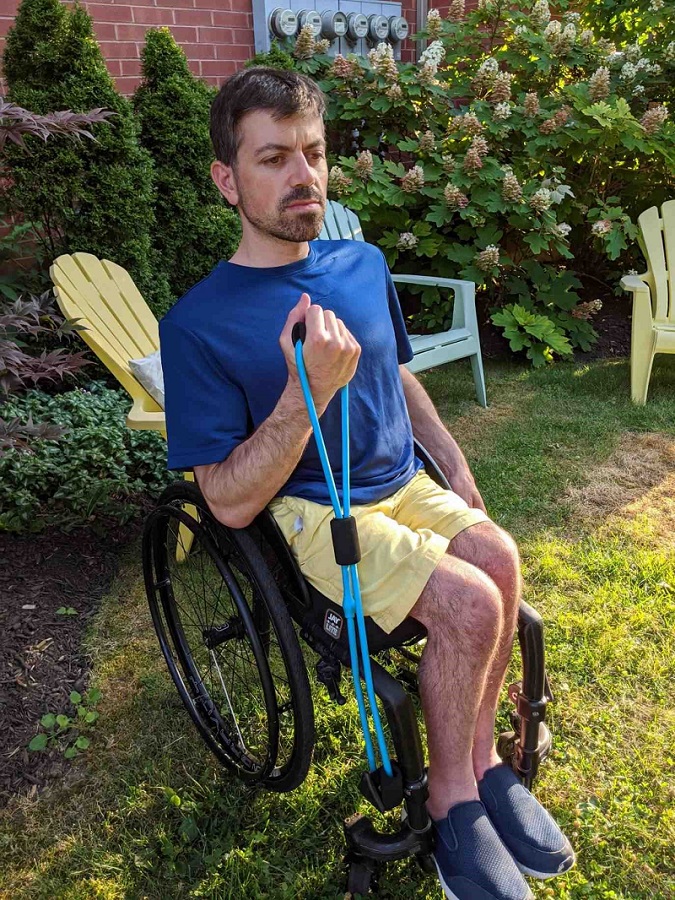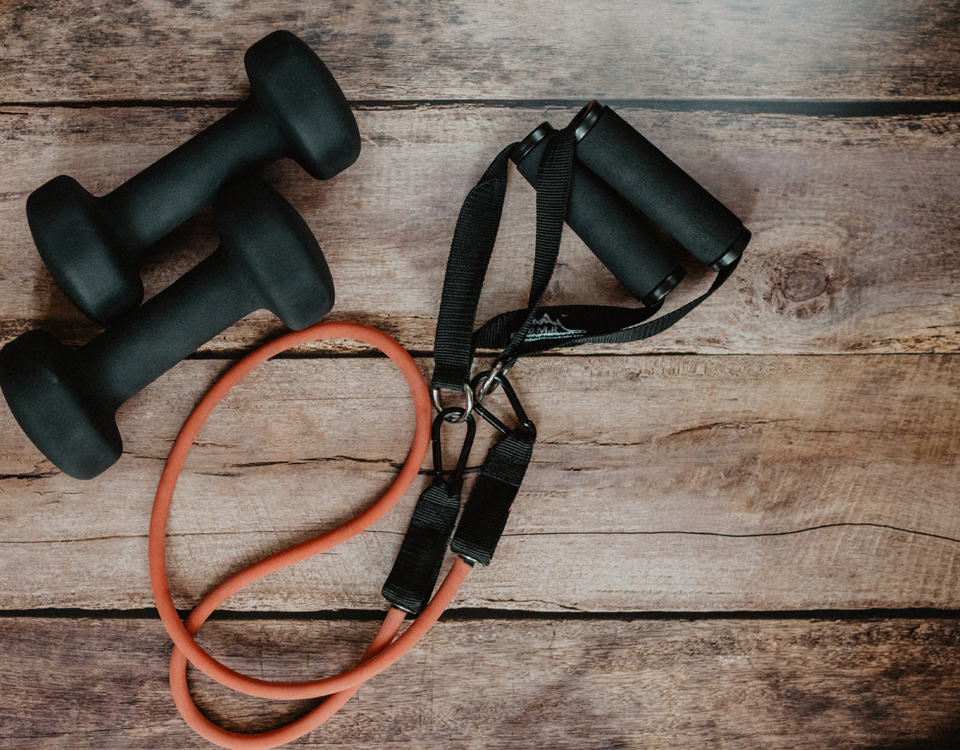Tips for exercising at home in a wheelchair
No more gyms? No problem. Here’s how wheelchair users can stay fit at home
No more gyms? No problem. Here’s how wheelchair users can stay fit at home
As we savour the remaining few days of summer and look to cooler months ahead, wheelchair users might be scratching their heads wondering how they can stay active while at home.
Health experts have continued to raise concerns that indoor exercise facilities help spread COVID-19 virus due to the higher frequency of touched equipment and close proximity of persons who cannot stay physically distant. With this in mind, it’s likely that many fitness centres will remain closed for the time being.
For gyms that have reopened, it has created a number of challenges that make one wonder if it’s even worth the risk of going at all. From the constant sanitizing of equipment and surfaces, to mask requirements that make cardio workouts nearly impossible, it has made for a precarious environment for almost everyone.
However, if you have a disability, it can be even more challenging when you consider how often our hands touch objects, surfaces and especially our very own wheelchairs. Even more problematic is the historic lack of accessible exercise equipment in fitness centres, such as arm ergometers or reachable-weight lifting devices.
Furthermore, physical-distancing has taken out the relative ‘fun’ of going to the gym for those who thrive in group classes or social workouts with their friends. And while I typically prefer working out in relative isolation, I miss observing what other gym-goers are doing. Watching someone else’s grueling bench-press or marathon-esque cardio session always gave me the motivation to work even harder on my own.
Given all these considerations, it has been nearly six months since I last entered a gym.

During this span, I’ve had the time to reflect and change my own approach, building a customized in-home workout. It’s not perfect (and I still really miss my fitness club) but I feel like I’m starting to make progress. It has involved creativity, patience and structure - but I’m well on my way to maintaining my fitness goals.
The following are a just a few ideas on how wheelchair users like my myself can stay active while at staying safe at home:
The anxieties of a global health crisis in tandem with the distractions of working from home led me to explore the benefits of meditation this past spring. Studies have shown that regular meditation can help to remove anxiety, stress, pain and insomnia.
The onset of popular smartphone apps in recent years such as “Headspace” and “Calm” have made the practice of ‘mindfulness’ much easier. In fact, I’m starting to build it into my mornings several days throughout the week. I find that it’s a great way to start the day on a clear and positive note. I also feel like meditation is helping to produce even more ‘energy’ and ‘focus’ than a cup of morning coffee or tea.
It’s also a great lead-in into physical exercises. If you’re new to meditation, I recommend carving 10 minutes into your morning to start, while eventually progressing up to 20 - 30 minutes once you feel comfortable. Be sure to track your progress using your preferred iOS or Android app. You’ll likely start noticing an impact in just a few days.
Over the years, I’ve been guilty of not putting enough effort or time into my pre-and-post stretching routines. Often, this resulted in muscle tweaks - and perhaps even full-out injuries. But as I’ve gotten older, I realize how important stretching exercises are to the overall quality of my life.
Quite simply, I’ve used a wheelchair for nearly 30 years and my shoulders have taken an absolute beating. To keep them in the best possible shape, I regularly start my in-home workouts with a simple “I, Y, T” exercise for a few minutes. It involves manipulating your shoulders in different directions to improve your range-of-motion and posture.
Depending on your abilities, it can be easily done in a bed, bench, table, with a medicine ball or simply in your wheelchair. Here’s a video that can help guide you through the motions.
There are of course different methods of stretching that can involve a rope, elastic or your own creative arm or body exercises. But really, the key is to stretch your body before any workout to avoid injuries.
At the conclusion of all workouts, I’ve also found that using a tiger-tail type product can help alleviate some muscle tightness in my arms and neck. It’s an inexpensive and worthy purchase especially if you don’t have access to a massage therapist or trainer.
Throughout the spring and summer, it’s been relatively easy to take my hand-cycle or wheelchair outdoors and discover nearby trails and roadways. There’s nothing quite like getting a cardio workout in while also enjoying the ambience of nature. With winter on the horizon, I’m making plans to use my bike on a trainer-stand in my garage (sidenote: I’m converting my garage into a gym over the next month).
My in-home cardio workouts will typically involve a minimum 15 minutes on the bike before proceeding to any weights or resistance exercises. At the end of my exercise sessions, I’ll re-enter the bike to do a quick-cool down for 5 minutes. And once a week, I’ll complete a 45 minute session on the bike without pursuing any weight exercises after.
For those without a handcycle, you can purchase an arg ergometer off Amazon or your local fitness or medical store. They can easily be placed on firm kitchen tables or countertops if you don’t have the space in your home for your handbike.
Cardio workouts are an important part of my week. Without that level of energy exertion - or exhaustion for that matter - my body just doesn’t feel the same. And given how much time I spend sitting in a wheelchair, it’s an important way for me to burn calories and improve blood circulation throughout my body in colder months.
Out of all my in-home workouts, this is the one that has involved the most creativity. Given that I have zero interest in purchasing different sets of dumbbells or a complex weight machine, most of my workouts have involved resistant bands, medicine balls and body manipulation to get the job done.
Resistance bands can be tied to your door, a table or a wall-mounted hook. Once safety tethered, you should focus on opposite-motions. For example, wheelchair users are always using a forward motion in their pushes. To avoid long term injuries and to build muscles, you should focus on opposite motions. There are a number of great online resources on how to use resistance bands on your own. In particular, SCI Alberta has a great video to get you started.
I also spend time exercising using a medicine ball. Slowly lifting the ball, alternating positions side-to-side and over your head multiple times can really improve your core muscles. Even better - if you have the ability to do these exercises in front of a mirror, you can ensure your posture remains aligned. You don’t want your arms or shoulders to appear at different angles. It can be quite easy for your dominant arm to do most of the work. This can lead to serious injuries, so be careful to take things a bit slow. My former trainer would always mention to me that “posture equals performance” and I encourage everyone to heed those words!
Wheelchairs users who want to stay active while at home are incredibly lucky to have thousands of different product choices at their fingertips. If anything, it can be incredibly overwhelming to choose the right ones. Moving forward, I am hoping that home gym equipment companies can improve their products by making them more accessible and inclusive.
For those who are ready to start their workouts in-home, the possibilities are endless. However, given that no disability is quite the same as another, it’s important to speak with your doctor, physiotherapist or certified trainer to ensure you’re working on the right things.
Have ideas to share? Feel free to send them to us on social media! Or email me at joeldembe@gmail.com
Happy training!
Disclaimer:
The views and opinions expressed in this post are for general informational purposes only and are not intended to provide specific advice or recommendations for individuals. Any further guidance should be discussed with a licensed professional and/or licensed provider.
